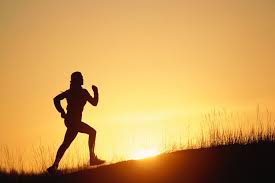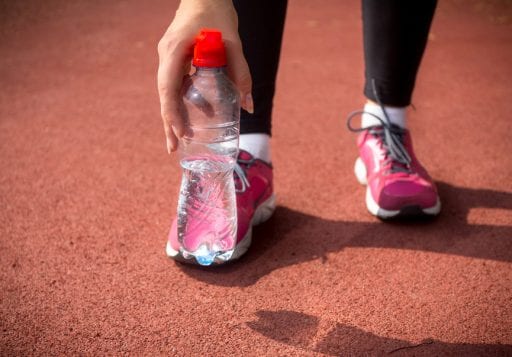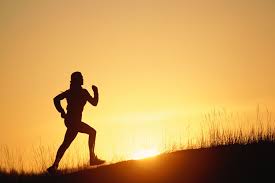Updated on June 9, 2017
Daily exercise is critical to success after weight loss surgery. If you exercise outdoors, you need to know how to exercise safely in hot weather. Protect yourself against heat-related illnesses by avoiding working out in extreme heat, staying hydrated and wearing the right clothing.
It doesn’t take much to work up a sweat in the heat of summer. In Oklahoma, and pretty much anywhere in the southern U.S., exercise becomes more of a challenge when the mercury rises.
Many people head indoors to a comfortable air-conditioned gym, but not everyone wants to exercise indoors.
How Hot Weather Makes Exercise Harder
Heat adds to the difficulty of exercise. A workout requires more effort as temperatures increase. If you aren’t careful in heat, you may become ill.
When exercising in high temperatures, the body cools itself by sending blood to the skin. Less blood and oxygen is available to power muscles. Your heart rate increases as muscles work harder.
If the weather is both hot and humid, sweat won’t evaporate as quickly. This makes you even hotter. Here are some tips about how to exercise safely in hot weather.
Strategies to Beat the Heat
Check the weather forecast before you go outside. Know what to expect and be prepared. Take your phone with you. Let someone know where you’ll be walking, jogging or exercising.
Avoid peak heat: Work out in the morning or evening to take advantage of cooler temperatures. Seek out shady parks or trails.
Drink fluids: After weight loss surgery, staying properly hydrated may be challenging. Add heat and exercise into the mix, and you must be even more diligent about drinking fluids. Always carry water with you. Drink before and after you exercise. Speak with your dietitian about using a sports drink since some formulas are high in sugar.
Easy does it: If you walk, run or bike, slow your pace or shorten the distance. Whatever your form of exercise, dial down the intensity. You’ll still get a good workout at a reduced effort.
Water workout: Find a pool and take advantage of the cooling effects of water. Swimming, water walking and water aerobics are great ways to stay fit.
Know your limits: If you’re new to exercise, or haven’t worked out for awhile, start easy. Your body will get stronger, and you’ll adapt to heat. Many experts recommend allowing at least two weeks to get acclimated to heat. Take breaks as you need them.
Invest in workout clothes: Wear wicking, light-colored clothing designed for exercise. So-called technical fabrics keep you cooler by speeding moisture evaporation and allowing air to flow. Workout gear often has the added benefit of built-in UV protection.
Use sunscreen: Sunscreen won’t keep you cooler, but can help you avoid sunburn and sun damage.
Talk to your doctor: Some medications or health conditions increase the risks of heat-related illness. Make sure you understand your medical condition by speaking with your doctor.
There are times when weather makes it too dangerous to exercise outdoors. Even if you hate the idea of a treadmill or a gym, embrace the idea of air conditioning and moving toward your fitness goals. Gyms offer temporary memberships. Give one a try!
Heat-Related Illnesses You Need to Know About
Your body’s cooling system adjusts to keep you safe when you work out. But when the weather gets extreme, or you stay out too long in heat and humidity, you could develop a heat-related illness.
After weight-loss surgery, many of our patients are super motivated to stick with their exercise routine. We encourage everyone to get out and move, but we want you to be safe as you walk, run or play ball this summer.
Some people find it challenging to drink enough to stay hydrated in the heat. The reduced size of your stomach pouch means you will feel full quickly. After surgery, you might need to be especially conscious of getting enough fluids when you exercise in heat.

When you’re working out in the summer, listen to your body. Stop and rest in the shade if you begin to feel overheated, nauseous or lightheaded.
Call 911 if it’s an emergency, or ask someone to assist you. While some heat illness is mild, in severe cases you can pass out or become dangerously ill.
Here are some symptoms to watch for, listed from mild to dangerous:
Heat cramps are strong, painful muscle contractions are heat cramps. They are often an early sign of heat illness.
Lightheadedness, or heat syncope, may cause you to pass out. You may experience this if you’ve been standing for a long time, or when standing up from a sitting position. Some people faint immediately after stopping exercise, such as after crossing the finishing line of a race.
Heat exhaustion. Don’t ignore the symptoms of this serious condition which can lead to heatstroke. Heat exhaustion is when your body temperature rises to dangerous levels, as high as 104 F. Symptoms include nausea, vomiting, weakness, headache, and cool, sweaty skin.
Heatstroke is a potentially fatal condition. It happens when body temperature rises above 104 F. People with heatstroke need immediate medical attention.
Call 911 if you think you have heatstroke. Symptoms include a lack of sweat even though the skin feels hot. If heatstroke occurs during exercise, you may continue sweating for a short time after stopping exertion.
Stop Moving and Take Care of Yourself
If you overheat while working out, cool yourself immediately by doing the following:
- Stop exercising.
- Pour water on your head, neck and body.
- Place a cold pack or ice on your neck or forehead.
- Rest in the shade and drink water.
- Remove extra clothing.
- If you still feel ill after 30 minutes, call a doctor.
WeightWise hosts free informational seminars on weight loss surgery. Sign up today.

